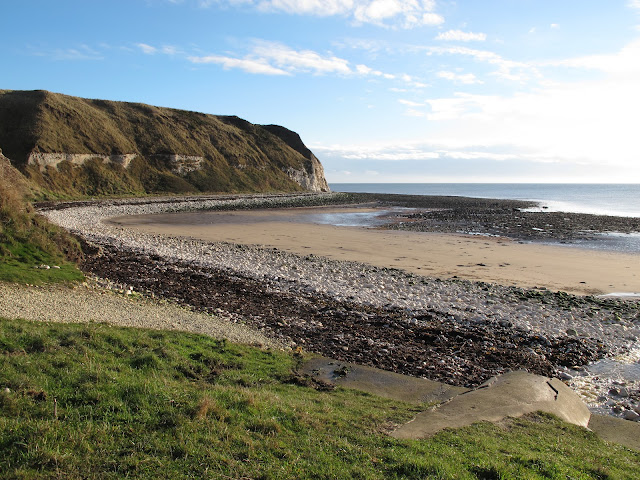This is the site where the Yorkshire Wildlife Trust has planned its Living Seas Centre (above), which is bound to open in the spring. There are several marked trails, peppered with picnic benches, sculptures and even a 'dinosaur's nest' for the little ones. There is a bird feeding station with a screen, but today it didn't appear to have been stocked.
The sky was clear and the breeze northerly, so the landing was quite balmy considering the widespread frost. It took me some time to leave the carpark, as it was teeming with birds, Yellowhammers, Tree Sparrows, Song Thrushes and Bullfinches to name a few.
I descend into the sheltered little bay, accompanied by the bubbling noise of the running creek. It was low tide and a wide beach opened ahead of me, backed by the clay and chalk cliffs. The top of the beach, under the seaweed covered tide like is made of white chalk boulders, but then there is a strip of sand. Instead of the planned walk to Danes Dyke, I walk right and then left and generally hang out with the beach birds, which appear unusually tame.
Pied Wagtail
Rock Pipit
Carrion Crow and Turnstone
Carrion Crow
Turnstone
A pair of Carrion Crows are busy turning the seaweed in search of food with some Turnstones. A Pied Wagtail goes back and forth by the creek pouring into the beach. There are Rock pipits and Turnstones everywhere.A group of Turnstones climb onto the cliff and proceed to dig the clay out - maybe they should have been called the Cliff-Diggers (above). The Rock pipits seem interested in this activity too.
Later, I see what I initially take by a pair of albino Turnstones amongst normal looking ones, but when I look closer they turn out to be some lovely Sanderlings.
A large flock of unidentified finches flies back and forth by the cliff tops.
Great Black-Backed Gull and Oystercatcher
By the water edge there are Great Black-Backed and Herring gulls, with a couple of Curlew, a Ringed Plover, Oystercatchers and Redshank.
Ringed Plover
Limpets
Looking towards the headland by a rock pool
Before leaving, I climb to the cliff top and follow the trail by the ravine. There are several blooming gorse bushes and then the trail becomes more wooded, with some mature trees and younger ones. I spot a Treecreeper and a Chiffchaff, and later, a bunch of Long Tailed Tits.The headland is as interesting and fascinating in winter as it is in spring and summer, when the cliffs are busy with breeding seabirds. I can't wait to be back.
The 'dinosaur nest' on the nature trail
Chiffchaff
Treecreeper
More InformationFlamborough Bird Observatory.
Yorkshire Wildlife trust.
Location map
View Larger Map
Bird list
- Blackbird
- Bullfinch 4
- Carrion Crow, a recently fledged young begging to its parents in the car park
- Chaffinch
- Chiffchaff 1
- Curlew
- Dunnock
- Goldfinch
- Great Black-backed Gull
- Great Tit
- Greenfinch
- Herring Gull
- Long-tailed Tit 6
- Oystercatcher
- Pied Wagtail
- Redshank
- Ringed Plover 1
- Robin
- Rock Pipit 10 C
- Sanderling 2
- Song Thrush 2
- Stonechat
- Tree Sparrow
- Treecreeper
- Turnstone, about 20
- Woodpigeon
- Wren, singing male
- Yellowhammer 2
- unidentified diver











































